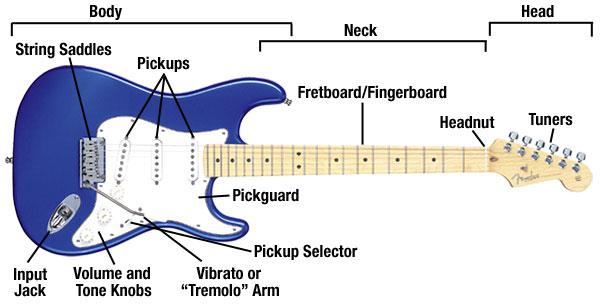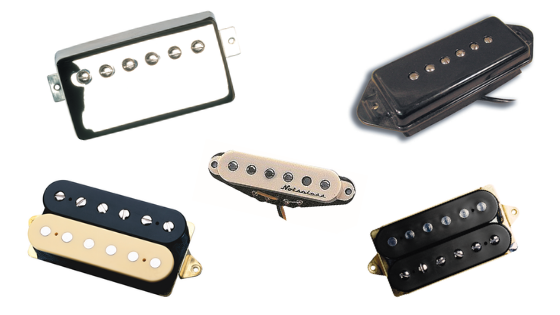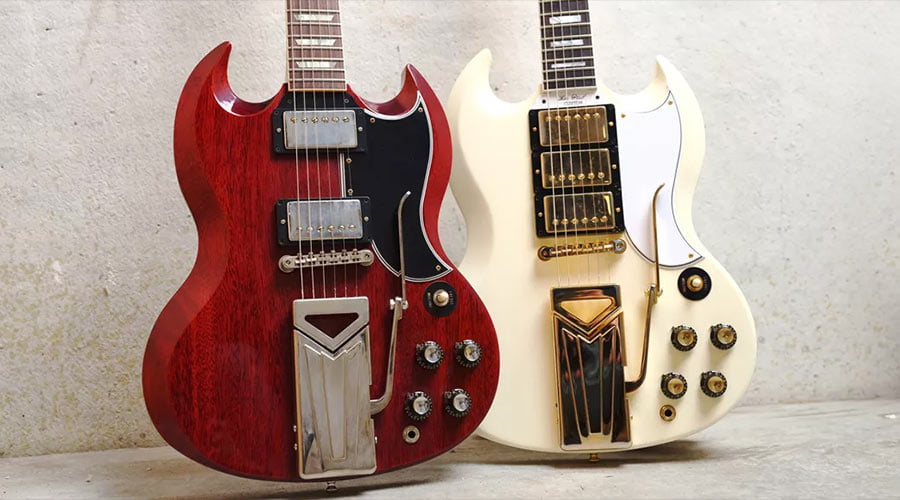  
|
 sections on this page
sections on this page Parts of the guitar
Parts of the guitar  Different pickups
Different pickups Different body styles
Different body styles |
 The basics of electric guitars
The basics of electric guitars Parts Of The Guitar
Parts Of The Guitar
The headstock, found at the very top of the guitar, maintains the tension and tuning of the strings through the tuning pegs found on it. Headstock design is largely up to your own taste, but its shape does affect playability. A straight headstock, or flat headstock, where all the tuning pegs are in a straight line is simple and easy to tune (see Fender Stratocaster). However, it can make the tuning less stable and cause string slippage which leads to fret buzz. The 3x3 design, where one side of the headstock holds three tuning pegs while the other holds the other three, is just as common (see Gretsch Duo Jet). The 3x3 design fixes the tuning issues of the straight headstock with the only issue being that many people consider it to be less visually appealing than other headstock designs. Some guitars do away with headstocks entirely, but those are significantly more difficult to restring (see Strandberg Boden Standard). The tuning pegs, also called machine heads, are where you tune the guitar. The pegs have a hold going through them which the strings run through before wrapping around the peg. Turning the peg clockwise increases the string tension which increases the pitch, turning the peg counterclockwise does the opposite. The two main types of tuners are standard tuners and locking tuners. Standard tuners work the same way I have described but locking tuners do not require that you wind the string around it. Instead, the tuner clamps down on the string, holding it in place. This makes string changes faster and easier while also making the tuning more stable. The neck is what connects the headstock to the body and where you will hold the guitar when you play. Necks can come in different shapes, lengths, and widths. The most common shapes are C shape, U shape, D shape, and V shape. It's up to your own personal taste which neck type is better, so experiment with whatever feels best in your hands. The fretboard, also called a fingerboard, lies on top of the guitar neck. It's a long flat piece of material, typically wood, that is divided into sections called frets. The frets determine the pitch of the notes when pressed. Typically, there are marks on the fretboard for the 3rd, 5th, 7th, 9th, and 12th frets, usually one dot on each with two dots on the 12th. The strings of your guitar can have a decent impact on your sound. Instead of there being nylon and steel strings like on an acoustic guitar, now there's just steel. The strings come in different gauges, usually determined by the gauge of the high E string. The lighter the gauge, the sharper and lighter the sound. The heavier the gauge the deeper and darker the sound. Most guitars come in either .009 or .010 gauge which is somewhere in the middle of that sharp and deep tone. The body of an electric guitar can vary quite a bit. Electrics come in either solid body, semi-hollow, or hollow body. All the body types have their own benefits and drawbacks and I'll talk more about then later on this page. The pickups are what make an electric guitar electric. The pickups convert the string vibrations into an electrical signal that is sent to the amplifier which then amplify the sound. Pickups typically come in three types, single coil, humbucker, and p-90. I will also talk about them in more detail later in this page. The pickguard is the material at the side of the sound hole. Its purpose is to protect the guitar's finish from being damaged by your picking hand or guitar pick. Whether-or-not this is an actual problem however, is mainly up to how you play. For many players pickguards are more for the look of the guitar rather than any actual purpose, and many guitars don't have them. The bridge is the small stump at the bottom of the guitar. The strings are run through holes in the bridge and are tied so they don't slip out and can be tightened and played. The big difference between an acoustic bridge and a electric bridge is the addition of a tremolo. 
Types of pickups As I said before there are generally three types of pickups: single coil, humbucker, and P-90. Single coils pickups are most commonly found on Fender or Fender style guitars like the Stratocaster or Telecaster. They have a very distinct twangy or sharp sound to them. However, they produce a humming sound when sitting idle. Humbuckers get their name from the elimination of that humming sound made by single coil pickups. They have a more rounded, warm sound and appear often on Gibson style guitars like the SG or ES-335. The P-90 is a middle ground between the single coil and humbucker. They focus on that mid-range tone and develop a unique sound of their own.  Different Body Styles
Different Body Styles
Electric guitars generally come in three styles, solid-body, semi-hollow, and hollow body. Solid body guitars get their name from being made of multiple pieces of solid wood. Since they are not hollow and have little resonance their sound is unique. The lack of resonance means that they have less feedback when plugged in to high gain or volume amplifiers, meaning you get a more consistent and controllable sound. They offer a more clear high pitch treble at the cost of a more limited bass and mid-range. One of solid body guitars greatest benefits comes not from their sound but the shape of the guitars themselves, since they don't need to be hollow for resonance they can take on any shape you can make. Take for example the differences in shape in the Gibson Les Paul, SG, Explorer, and Flying V and the Fender Stratocaster, Telecaster, or Meteora. Semi-hollow body guitars are often the same shape as a hollow body guitar but with a solid slab of wood in the middle of the body. This is done to try and achieve the best of both worlds in the guitar, a rounded warm sound with a strong bite when needed. Like their solid body sisters they have less feedback when plugged in at high gain or volumes but still less than a solid body guitar. They can fit into any genre and have given the most famous semi-hollow guitar, the Gibson ES-335, the title of "The only guitar you'll ever need". (As a side note, you may recognize the ES-335 from Back To The Future but that's actually a ES-345, which is pretty much the exact same thing but with some better electronics) Hollow body guitars are becoming increasingly less common. They offer a warm, clean, and precise sound and are very light which is a big plus if you play standing up for long periods of time. They are used typically in jazz, blues, and country but find a hard time landing in other genres. They high feedback when played with large amounts of gain or volume makes them less than ideal for things like rock or metal. However, they were the first ever electric guitars and you'd be remiss if you didn't check one out just to see what they're like. 
Electric guitars can have no cutaways, a single cutaway, or a double cutaway. Although nearly no electric guitars have no cutaway. Most have a single or double cutaway, like the Gibson SG shown above whose double cutaway give it it's signature horns. 
|
|
|
